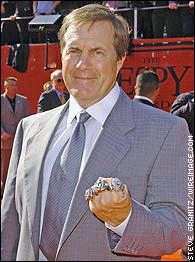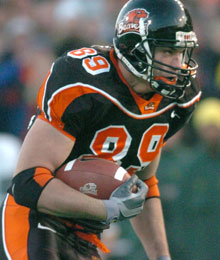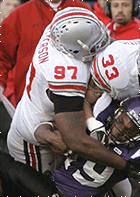2007 NFL All-Undrafted Team
The draft is now over, and 255 players will now prove their worth in NFL training camps. But what about the players who went undrafted? We often forget the players who go undrafted, Hell, we forget most of the players who get drafted after the 1st round. Just because a player was passed on doesn’t mean he is not worthy of being in the NFL. Sure, they got rejected-255 times-but many of the game’s greats either were drafted late or not at all. The Rams won a Super Bowl on the shoulders of Kurt Warner, a player who went undrafted from 1-AA Northern Iowa. Jake Delhomme, Priest Holmes, and Wayne Chrebet all went undrafted as well, yet all have found success in the league. Antonio Gates went undrafted, and is now a Pro Bowl tight end. Rod Smith went undrafted and has become one of the most consistent performers ever at the WR position.
This made me wonder: Who could be the next diamond in the rough? Which undrafted players eligible this year may end up on an NFL team eventually? What if some coach/GM were to develop a Bill Belichick-like hubris and compose an entire starting lineup out of undrafted college stars? Somewhere out there, an NFL coach or GM might have developed such an ego that he thinks to himself “You know what? I’m so good at this, I’ll bet I can take an entire team of undrafted players and make a winning team!”. Who would he pick?

This post seeks to answer that question. I will provide 22 players, 11 on offense and 11 on defense, whom could stand a chance at an NFL career. Presenting the 2007 NFL All-Undrafted Team:
Quarterback-Jared Zabransky, Boise State.

- Why he wasn’t drafted: Zabransky has a throwing motion similar to that of a fish. He also isn’t comfortable in the pocket, and at a mid-major often did not play against good defenses.
- Why he could play in the NFL: Of all the quarterbacks in the draft this year, the southpaw ginger had the highest winning percentage of them all (33-5, 23-1 in the WAC). And while his throwing motion is suspect, Zabransky completed 66.3% of his passes for 2587, 23 touchdowns and only 8 interceptions. He had the 6th highest QB efficiency in Division 1-A (sorry, Bowl Subdivision), and the second best of any undrafted quarterback, behind Pittsburgh’s Tyler Palko.
- Other worthy candidates: Palko, Zac Taylor (Nebraska).
Running Backs- Jon Cornish, Kansas and Steve Baylark, UMass.


- Why they weren’t drafted: At 5′11” and 106 pounds, the Canadian Cornish is slightly undersized for an NFL back. He didn’t compensate with speed, running a 4.62 40 (most top prospects ran in the 4.4 range). He also didn’t play for a collegiate powerhouse, obscured behind Mark Mangino’s fat ass. Had he achieve his same stats playing for a team like USC and the svelte Pete Carroll, He certainly would have been drafted in day 1. Baylark didn’t garner much attention because, well, he played for UMass, and unless you are directly associated with a school, it’s hard to keep track of Division 1-AA (sorry, Championship Subdivision). His 4.7 40 time was another strike against him.
- Why they could play in the NFL: Adrian Peterson’s injury affected this statistic, but Cornish led the Big 12 and all undrafted Bowl Subdivision (yech, that’s a mouthful) players in rushing with 1,457 yards and 8 touchdowns playing for the Big 12 North’s best rushing attack. Baylark led ALL of Division I with 1,960 yards in his senior year, and 5,332 yards over his career at UMass. Since most NFL teams must now resort to a two halfback system, both of these players could make excellent contributions even as secondary backs.
- Other worthy candidates: Darius Walker (Notre Dame), Josh Allen, Maryland.
Wide Receivers- Jerard Rabb, Boise State and David Ball, New Hampshire.


- Why they weren’t drafted: Like Baylark, Ball cut his teeth in 1-AA (that other name is too long). Scouts may also consider him too small (6′) to be an inside receiver and too slow (4.65 40) to be a deep threat. The third and final strike against him in NFL teams’ eyes, as silly as it seems, could be that he’s a white guy playing receiver. Despite having the right physical tools, Rabb began his career in community college before going to Boise State, which could lead to questions about his character, a big no-no in Roger Goodell’s new world order.
- Why they could play in the NFL: Ball set a new Division 1-AA record for career touchdowns with 50, breaking Jerry Rice’s old mark. Over his career he amassed 4,655 yards on 304 receptions. As for Rabb, I could describe his statistics, or his physical prowess, but all you need to see is this video:
- Other worthy candidates: Terry Moss (Ball State, highest yards per catch in NCAA).
Tight End- Joe Newton, Oregon State.

- Why he wasn’t drafted: The NFL wasn’t particularly interested in tight ends this year, only drafting three in the first three rounds, one simply by virtue of being a tall, fast TE playing for Miami. Newton missed the entire 2005 season due to injury, so scouts may have had health concerns as well.
- Why he could play in the NFL: The guy is 6′7″, for crying out loud! Even with an average 40 time for his position (4.9), his size makes him an easy target and a quarterback’s dream in the red zone (he had 14 TD catches in two full seasons as a starter). It also could help him develop into a great lead blocker.
- Other worthy candidates: Johnny Harline (BYU).
Offensive Line- Nathan Bennett (G) and Marion Dukes (T), Clemson, Daniel Inman (T), Georgia, Eric Robertson (G, no photo), California, and Lyle Sendlein (C), Texas.




- Why they weren’t drafted: Since they don’t accumulate stats (except sacks allowed), very little is known about offensive linemen at first glance (or at all, for that matter).
- Why they could play in the NFL: I chose these linemen for three simple reasons: 1) they played for big programs and thus faced tough defenses; 2) their quarterbacks were among the least sacked in the nation; and 3) in the case of all but one (Inman), their teams had a formidable running game. Those metrics, while simple, are all indicators of a great offensive line.
- Other worthy candidates: Scott Smith (Cal), Matt Spanos (USC), Renardo Foster and Kurt Quarterman (Louisville), Dan Mozes (West Virginia).
BONUS! Kicker- John Vaughn, Auburn.

- Why he wasn’t drafted: Auburn vs. LSU, October 22, 2005. Vaughn was 0-4 on field goals, including a 39 yarder to win.
- Why he could play in the NFL: The rest of his college career. Since that game, he has been one of the best kickers in the nation, becoming a finalist for the 2006 Lou Groza Award.
- Other Worthy candidates: Vaughn’s backup at Auburn, Matt Clark. I base this on absolutely nothing.
Defensive Ends- Mkristo Bruce, Washington State and Justin Hickman, UCLA.


- Why they weren’t drafted: Neither of these guys is a prototype NFL defensive end. Hickman in particular is small for the position, and the fact that he spent his first two years in community college raises questions about his past, which may have scared suitors in the Roger Goodell era. Bruce posted a bad 40 time (5.03), and most of his stats apparently came against inferior competition.
- Why they could play in the NFL: Both of these players were members of the 2006 All-Pac-10 defensive team, combining for 162 tackles, 47 tackles for loss, and 30.5 sacks in their senior campaigns. A lot of NFL teams could use that kind of help. In a draft without combines, they both may have gone of the board on day 1. Bruce could still be able to gain 20-30 pounds and be able to stand up to most any NFL offensive tackle.
- Other worthy candidates: Victor Degrate, Oklahoma State; Bryan Andrews, Wake Forest.
Defensive Tackles: Ray McDonald, Florida David Patterson, Ohio State and Joe Anoai, Georgia Tech.


- Why they weren’t drafted: It was really difficult to guage a defensive tackle with statistics, because they have the fewest of any defensive players. Both of these players had to battle injuries while in college, Anoai in particular.
- Why they could play in the NFL: Anoai has been excellent in penetrating opposing offensive lines, as nearly 25% of his tackles in 2006 were for loss. For his efforts Anoai made 1st team All ACC honors. Patterson, along with Quinn Pitcock, helped anchor an otherwise very inexperienced Ohio State defense; they ultimately ranked higher in in total defense overall versus 2005, despite the fact that Patterson and Pitcock were the only returning starters.
- Other worthy candidates: Ramel Meekins, Rutgers.
Linebackers- Desmond Sims (OLB), Arkansas, Quinton Culberson (MLB), Mississippi State and Tony Taylor (OLB), Georgia.



- Why they weren’t drafted: All of these players were passed on for different reasons. Sims is not great in coverage. Taylor has had to face serious injuries throughout his college career. Culberson played for an SEC doormat, has been in trouble with the law as a teenager, and was overshadowed in his own state by one of the top linebackers in the nation, Patrick Willis.
- Why they could play in the NFL: They have all been top performers in college against top competition. Sims is a freak athlete; he weighs 288 pounds but runs a 4.62 40. He can play linebacker or defensive end. Culberson was 1st team All SEC at linebacker with 102 tackles and 9 tackles for loss. Taylor, a second team All SEC winner, may have had the most impressive senior season of all, with 96 tackles, 7 tackles for loss, 2 fumble recoveries, 7 interceptions (5th in the NCAA at any position), and two defensive touchdowns. All could fare well in a Cover 2 scheme.
- Other worthy candidates: Jon Abbate, Wake Forest; Earl Everett, Florida (I could have SWORN that guy got drafted); Marcus Bacon, Missouri.
Cornerbacks- Kenny Scott, Georgia Tech and Anthony Arline, Baylor.


- Why they weren’t drafted: The case of Kenny Scott hits home for me. I was convinced that he was the caliber of an athlete that would get drafted on the first day. I even traded up in the second round of my mock draft to get him. However, scouts were scared off because his play was inconsistent, he was thin for his height at the position (6′1″, 179), and he was declared academically ineligible for the 2007 Gator Bowl, which I did not know before the draft. As if playing at the perennial cupcake that is Baylor didn’t make Arline obscure enough, he had to stand in the shadow of his teammate, C.J. Wilson.
- Why they could play in the NFL: Most of the top receivers in the NFL have an unbelievable combination of size and speed, so having one, let alone two, tall and fast corners is going to be a huge asset. Scott and Arline are 6′1″ and 6′2″ and run a 4.39 and 4.43 40 time, respectively. In addition to his stats (50 tackles in 2006) and ACC play, Scott has shown his abililty to come through on important plays as evidence by the video below. But beyond everything else, remember this: Kenny Scott has had to spend every day in practice for the last three years defending Calvin Johnson. He is ready to take NFL receivers’ best shots right now.
[youtbe=http://www.youtube.com/watch?v=-6uG01ph9S8&eurl=]
- Other worthy candidates: DeAndre Jackson, Iowa State; Travarous Bain, Hampton.
Safeties- Jesse Daniels, LSU and Melvin Bullitt, Texas A&M.


- Why they weren’t drafted: With the proliferation of the Cover 2 and offenses continuing to spread the field, having a good safety in the NFL is more important now than ever. This was reflected in the teams’ draft strategies, as nearly as many safeties (8) were drafted as cornerbacks (9) or linebackers (11). Yet neither of these two players were drafted. Bullitt (who has a great name for a safety) was a solid starter but did not have good hands, intercepting only 4 passes in his career. Scouts also thought he wasn’t aggressive enough. Daniels, despite his solid career, was playing sidekick to fellow Tiger safety and first round pick Laron Landry. Scouts believe he was too short (5′10″) and too injured to be a defensive back in the NFL.
- Why they could play in the NFL: Both of these players had stellar senior season, winning all-conference awards for their efforts. Daniels had 47 tackles and was helped the Tigers a lot in run support. Bullitt ran a 4.49 40, so he has the speed to keep deep pass plays in front of him. A typical NFL scheme would put Bullit at free safety and Daniels at strong safety.
- Other worthy candidates: Tra Battle, Georgia; C.J. Wallace, Washington.
BONUS! Punter- Sean Douglas, Washington.

- Why he didn’t get drafted: It’s a miracle to be drafted as a punter to begin with, but Douglas was not always consistent.
- Why he could play in the NFL: He has a cannon for a leg, and when consistent he is very accurate. He also has had to punt for four Seattle autumns, so he should be able to adapt to bad conditions.
- Other worthy candidates: Kody Bliss, Auburn.
So there you have it: the 2007 NFL All-Undrafted team. Think that any of these players are undeserving of this list or know any blatant snubs? Let me know in the comments.
Arizona Steve said
Great and timely article.
Right on the money.
But, you should have possibly noted that Zabransky was the fastest, quickest and could jump higher than any of the quarter backs and many of the other backs and wide received in their grouping at the NFL 2007 Combine. He had three first place and two second place finishes. He was high school player of the year. He set records running the quarterback option. A couple of years ago he set a Boise State record by scoring an 85 yard touchdown from scrimage. His natural toughness, quick thinking and athletic abilities will remind everyone of a cross between a young Farve and Garcia. And like them, he just knows how to win. The day of the pocket quarter is quickly disapearing. Defensemen are just to fast, strong and physically able to end the career of these high priced targets. Quarteback mobility and the threat to run is the only way to slow down defenses and slow down the defensive front four. Defenses must be forced to account for all eleven offenive players.
Hank Smith said
There is a player that has proven himself over and over again in the DIII and DI-AA divisions but has had players like Rhett Bomar overshadow him. He has many awards under his belt. The most recent were 2007 Offensive MVP scout team, Starting QB in the spring at Sam Houston State, and the list goes on. He is such an athlete that if he just had a chance to get a look, he would definetly not disappoint. He has been overshawdowed by other high profile players that the media overlooks him. He is one of the best team players a coach could ever ask for. He has raised the bar for other players as far as work habits. A scout, agent,or NFL team should contact his coach at Sam Houston State to inquire his elgibility to play in the NFL.
Hank Smith said
The players name I was refering to is Ryan Hinojosa